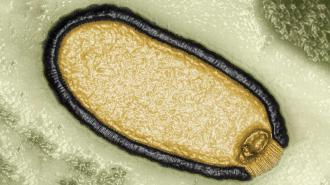A “zombie virus” was still able to infect hosts 48,500 years after it was trapped in frozen ground. Although this virus can’t infect humans, it suggests that the thawing permafrost could directly threaten human health if it releases other viruses that could.
The challenge: Permafrost is ground that remains frozen for at least two years straight, and it’s common on Earth — nearly 25% of the Northern Hemisphere qualifies.
There is a lot trapped in permafrost that we don’t want exposed — including ancient viruses.
But over the past 50 years, the Arctic has warmed at a rate three times faster than the world as a whole. This is causing parts of the permafrost to thaw, revealing mummified lions, wolves, and wooly mammoths that modern scientists can now study.
As exciting as those finds are, though, there is a lot trapped in permafrost that we don’t want exposed — including ancient viruses.
Ancient zombie viruses: Jean-Michel Claverie, a professor of economics and bioinformatics at Aix-Marseille University in France, has spent the past decade hunting for “zombie viruses” — dormant microbes that could still infect hosts after being frozen for hundreds or thousands of years.
His team has now published a new study detailing 13 viruses they isolated from samples of Siberian permafrost. When placed in petri dishes with amoeba, these viruses were all able to worm their way into the single-celled organisms.
Using radiocarbon dating of the permafrost samples, they determined that the youngest of the viruses was 27,000 years old, but the oldest was frozen 48,500 years ago — setting a new record for the resuscitation of a zombie virus.
“If the amoeba viruses are still alive, there is no reason why the other viruses will not be still alive.”
Jean-Michel Claverie
Why it matters: Claverie’s team only attempts to resurrect viruses that can’t infect people, plants, or animals, but they think those types of viruses could be revived from their frozen states, too.
“We view these amoeba-infecting viruses as surrogates for all other possible viruses that might be in the permafrost,” Claverie told CNN. “We see the traces of many, many, many other viruses, so we know they are there.”
“We don’t know for sure that they are still alive,” he continued, “but our reasoning is that if the amoeba viruses are still alive, there is no reason why the other viruses will not be still alive and capable of infecting their own hosts.”
Don’t panic: We already know that thawing permafrost can release microbes that harm human health — in 2016, a heat wave in Siberia exposed frozen reindeer that had been infected with the anthrax bacteria, which led to dozens of people being hospitalized and one boy dying.
However, while it is possible that a zombie virus could be a major threat to our health, it isn’t terribly likely — new viruses emerge regularly from living animals, and a permafrost virus would need to be highly contagious and capable of causing disease that we can’t readily treat.
Thawing permafrost is releasing potent greenhouse gasses, like methane, into the atmosphere.
The big picture: Ancient viruses aside, there are several reasons we should be worried about the thawing permafrost.
In addition to damaging the roads, buildings, and other infrastructure of Arctic communities, it’s also releasing potent greenhouse gasses, like methane, into the atmosphere, worsening the global warming that’s causing the thawing in the first place. Radioactive waste could be next.
Doing what we can to stop climate change will help prevent the problem from getting worse, but some scientists believe that we might be able to get some more immediate help from wildlife.
Studies have shown that using animals to compact the snow on top of permafrost can help keep the ground below frozen, and one startup is even looking to resurrect the wooly mammoth so that herds could keep the permafrost — and any zombie viruses in it — permanently frozen.
We’d love to hear from you! If you have a comment about this article or if you have a tip for a future Freethink story, please email us at [email protected].






